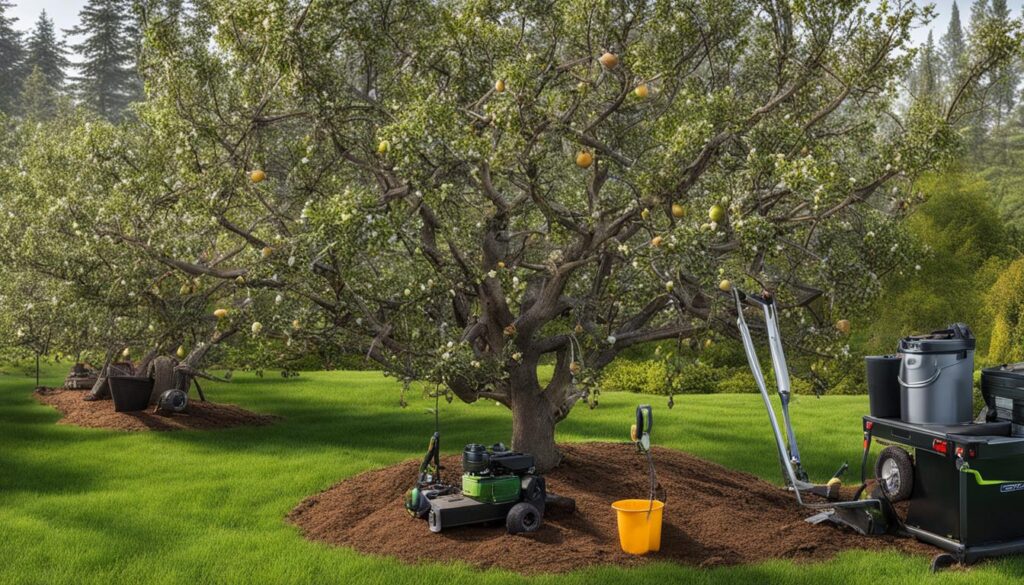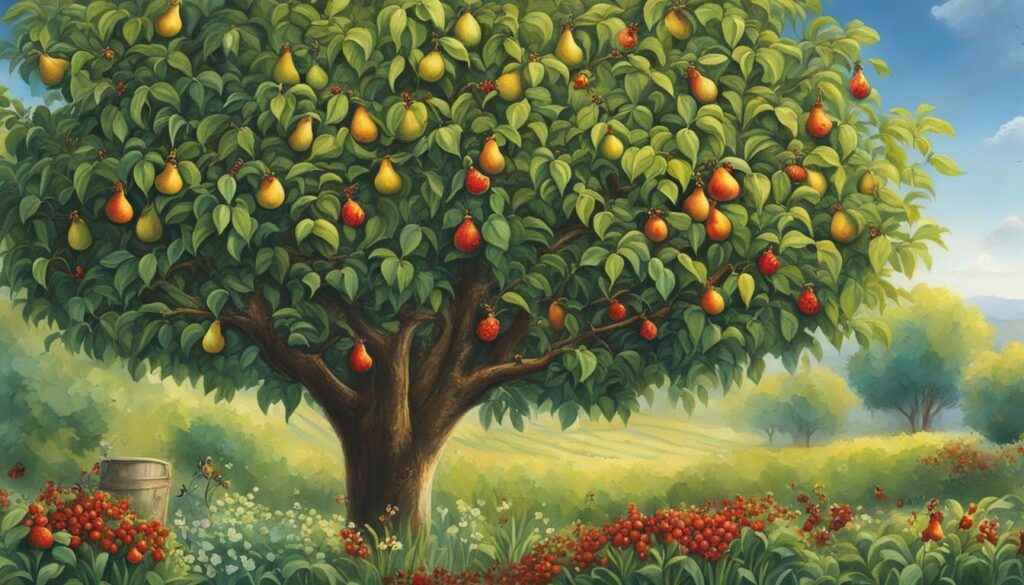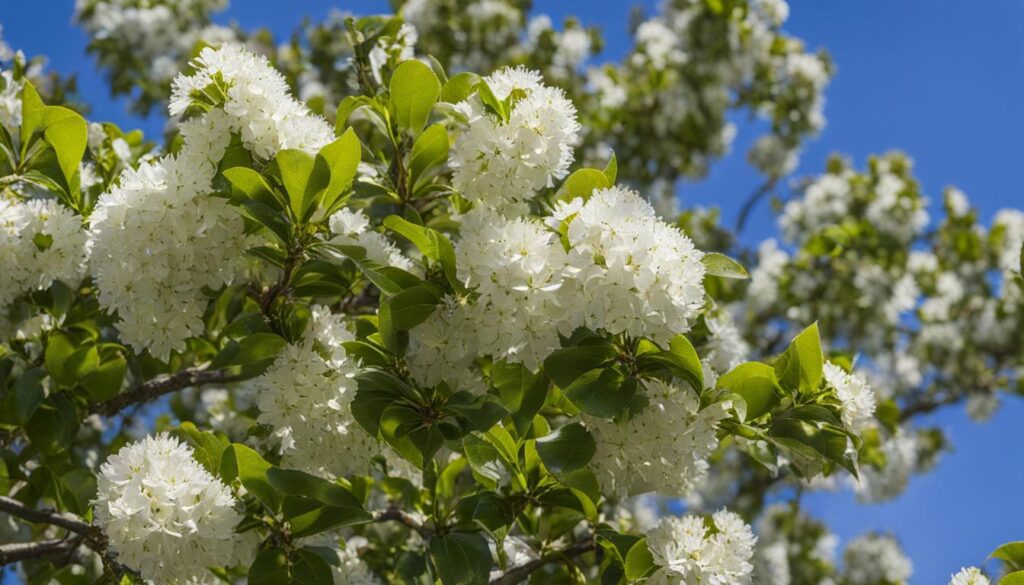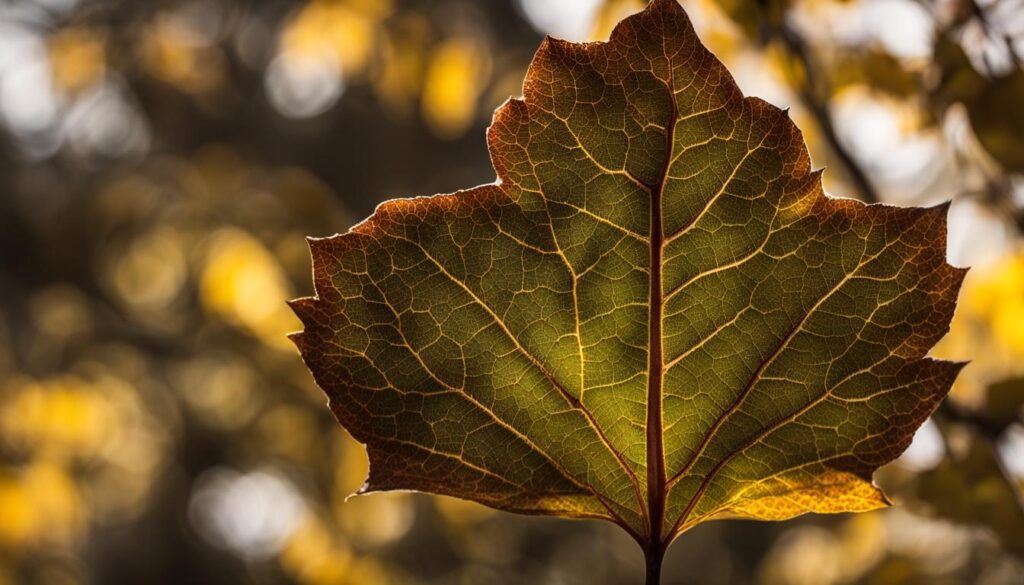Welcome to my guide on effective fire blight treatment for ornamental pear trees. Fire blight is a bacterial disease that can have devastating effects on these beautiful trees, causing wilting, blackening, and death of shoots, flowers, and fruits. If left untreated, fire blight can even spread to the main scaffolds, trunk, and roots, potentially killing the entire tree. But fear not, with the right treatment methods, you can protect your pear trees and keep them healthy and vibrant.
Key Takeaways:
- Fire blight is a destructive bacterial disease that affects ornamental pear trees, causing wilting, blackening, and death of shoots, flowers, and fruits.
- The disease can spread to the main scaffolds, trunk, and roots, potentially killing the entire tree.
- Effective treatment involves maintaining tree vigor, applying protective blossom sprays with bactericides and biologicals, and promptly removing and destroying infected parts of the tree.
- Early identification of fire blight symptoms is crucial for successful treatment.
- Fire blight management and control rely on factors like seasonal weather, orchard location, tree vigor, and proper application of protective sprays.
Signs and Symptoms of Fire Blight
Signs of fire blight include wilting, blackening, and death of shoots, flowers, and fruits on pear trees. Shoot tips may exhibit a characteristic crook. Sticky, amber-colored droplets containing bacterial cells may be present on blighted tissue. These symptoms can help identify fire blight and distinguish it from other diseases. Early identification is crucial for effective treatment.
To illustrate, the image below depicts a pear tree affected by fire blight, showing the wilting, blackening, and death of shoots and flowers.
Fire Blight Management and Control
To effectively manage and control fire blight, several factors must be considered, including seasonal weather conditions, orchard location, tree vigor, and the application of protective sprays. The development of fire blight is favored by warm, humid weather, particularly during spring or fall.
In order to prevent the spread of fire blight bacteria, it is important to use pear tree varieties that are resistant to the disease. Additionally, excessive pruning and the application of nitrogen fertilizer should be avoided, as these practices can weaken the tree and make it more susceptible to infection.
A comprehensive integrated pest management (IPM) program should be followed, which includes regular monitoring and timely treatments. Protective blossom sprays containing copper materials, streptomycin, and/or terramycin are highly recommended to minimize the spread of fire blight bacteria.
For more information on fire blight control and management, please refer to the recommended products section.
Influencing Factors for Fire Blight Management
Several factors can influence the management of fire blight in pear trees:
- Seasonal weather: Warm, humid weather conditions during the spring and fall can create favorable conditions for fire blight development. Monitoring and adjusting treatments accordingly is crucial.
- Orchard location: The geographic location of the orchard can impact the prevalence and severity of fire blight. Understanding regional climate patterns and disease history is essential for effective management.
- Tree vigor: Maintaining tree health and vigor through proper nutrition and irrigation practices can enhance the tree’s ability to resist and recover from fire blight infections.
By considering these factors and adopting appropriate management strategies, orchardists can effectively control and mitigate the impact of fire blight on pear trees.
Biological Control of Fire Blight
When it comes to preventing fire blight, biological control methods offer a promising solution. These methods involve the use of antagonistic microorganism formulations that act as natural enemies of fire blight bacteria.
By applying these formulations, you can prevent the colonization of blossoms by fire blight bacteria, effectively reducing the spread of the disease. These formulations are commercially available and can provide additional benefits beyond fire blight prevention. They have been shown to suppress frost formation and fruit russeting, further enhancing the health and productivity of pear trees.
Biological control methods are most effective when used in conjunction with antibiotic treatments like streptomycin. By combining these approaches, you can create a comprehensive and integrated fire blight management strategy.
It’s important to note, however, that some biological control formulations may be incompatible with certain fungicides and copper-based products. Therefore, it’s crucial to carefully review the product labels and consult with experts or extension services to ensure compatibility and maximize effectiveness.
To give your pear trees the best chance of remaining fire blight-free, consider incorporating biological control methods into your overall disease prevention and management plan.
Cultural Control Measures for Fire Blight
When it comes to preventing fire blight, cultural control measures are essential. As an orchard owner, I know the importance of taking proactive steps to stop the spread of this destructive bacterial disease. One crucial measure is the removal and destruction of cankers and infected limbs. By cutting these at least 8 to 12 inches below the visible injury, we can prevent the disease from spreading further and reduce the potential source of new infections.
In addition to proper pruning, it is crucial to sterilize pruning tools to avoid inadvertently spreading the bacteria. By practicing good sanitation and hygiene in orchard management, we can effectively reduce the risk of fire blight infections.
For those following organic practices, cultural control measures are of utmost importance. By combining organic methods such as cultural and biological controls with targeted sprays like terramycin and Bordeaux, orchard owners can effectively manage fire blight while maintaining organic certification guidelines.
Monitoring and Treatment Decisions for Fire Blight
When it comes to effectively managing fire blight in pear trees, monitoring the disease and making informed treatment decisions is crucial. That’s where temperature-based models come into play. These models utilize temperature thresholds and degree-hours to predict infection periods and determine the need for treatment.
By monitoring the temperature and calculating the degree-hours, you can identify the optimal timing for the first spray, which is critical for controlling fire blight. Subsequent treatments should be scheduled based on the accumulation of degree-hours to ensure continuous protection against the disease.
There are different temperature-based models available to assist in monitoring fire blight. The UC model, Maryblyt model, and Cougarblite model are among the commonly used ones. Each model has its own set of recommended treatment guidelines, allowing you to make informed decisions based on specific conditions and requirements.
It’s important to regularly monitor the temperature and follow the recommendations of the chosen model to ensure timely and effective treatment. By utilizing these temperature-based models, you can proactively manage fire blight and protect your pear trees from this destructive bacterial disease.
Recommended Products for Fire Blight Treatment
When it comes to treating fire blight, there are several recommended products that can help control the disease. These products have specific application rates, restricted use requirements, and efficacy against fire blight bacteria. It is important to follow label instructions and consider their compatibility with other treatments or sprays.
One commonly used product is streptomycin, an antibiotic that effectively targets fire blight bacteria. It is available in different formulations and can be applied as a spray, often in combination with other treatments. Streptomycin works by inhibiting bacterial growth, providing control against fire blight.
Oxytetracycline is another effective product for fire blight control. It is also an antibiotic and works by suppressing the growth of the fire blight bacteria. Oxytetracycline can be applied as a spray during the appropriate treatment windows to achieve optimal results.
In recent years, the use of pseudomonas fluorescens strain A506 and Aureobasidium pullulans strains DSM 14940 and 14941 has gained popularity for fire blight treatment. These biological control agents help suppress the growth and spread of fire blight bacteria. They can be applied as sprays, either alone or in combination with other treatments, offering additional options for managing fire blight.
It is important to carefully consider the specific needs of your orchard and consult with knowledgeable experts to determine the most appropriate products for your fire blight control program. Regular monitoring, combined with the use of these recommended products, can significantly improve the health and productivity of your pear trees.


Vinegar as a Fire Blight Treatment
Some gardeners have reported using a dilute raw apple cider vinegar spray to treat fire blight on pear trees. The active agent in vinegar is the microbe that makes the vinegar, which secretes an antibiotic that kills fire blight bacteria. While there is anecdotal evidence of its effectiveness, more research is needed to confirm its efficacy and determine the optimal timing of application.
To use vinegar as a fire blight remedy, mix one tablespoon of vinegar per gallon of water. Apply the mixture to the affected parts of the tree using a sprayer. The acidic nature of the vinegar helps create an unfavorable environment for the bacteria, reducing its growth and spread. Additionally, the antibacterial property of the vinegar may help inhibit the progression of the disease.
Organic Fire Blight Treatment Options
When it comes to treating fire blight in orchards, organic methods can provide effective solutions that align with organic practices. Cultural and biological controls, along with the use of specific sprays, can help manage fire blight naturally. Some of the organic treatments commonly used include:
Biological Controls
Biological control methods involve the use of antagonistic microorganism formulations to prevent the colonization of blossoms by fire blight bacteria. These formulations are commercially available and can also provide additional benefits such as suppressing frost formation and fruit russeting.
Protective Sprays
Specific sprays like terramycin, streptomycin, and certain copper products have proven effective in treating fire blight organically. These sprays can be applied following recommended application rates and schedules to reduce the spread of the bacteria.
To ensure compliance with organic certification guidelines, it is important to consult regulations specific to your region. Adhering to these guidelines will help maintain the organic integrity of your orchard while effectively controlling fire blight.


Implementing organic fire blight treatment options not only helps manage the disease but also promotes the overall health and sustainability of your orchard. By using natural methods, you can protect the environment and produce high-quality, organic fruits.
Prevention and Care for Ornamental Pear Trees
To ensure the health and vitality of your ornamental pear trees, it is essential to implement preventive measures and provide proper care. By following these guidelines, you can minimize the risk of fire blight and maintain the beauty of your trees for years to come.
1. Select Resistant Varieties: When choosing ornamental pear trees, opt for varieties that are resistant to fire blight. This can significantly reduce the likelihood of infection and make your trees more resilient.
2. Avoid Heavy Pruning: Excessive pruning can weaken the tree and create entry points for fire blight bacteria. Limit pruning to necessary maintenance and avoid trimming during periods of active disease presence.
3. Moderate Nitrogen Fertilizer: Excessive nitrogen fertilizer stimulates rapid growth, making the tree more susceptible to fire blight. Use a balanced fertilizer and avoid over-fertilizing, especially in late summer and fall.
4. Maintain Overall Tree Vigor: Healthy trees are better equipped to fight off infections. Provide proper irrigation, adequate sunlight, and regular maintenance, such as mulching and soil amendments, to promote tree vigor.
5. Monitor for Signs of Fire Blight: Regularly inspect your ornamental pear trees for symptoms of fire blight, such as wilting, blackening, or cankers. Early detection allows for prompt intervention and minimizes the spread of the disease.
6. Remove Infected Parts: If you notice any signs of fire blight, immediately prune and dispose of infected branches at least 8 to 12 inches below the visible injury. Sterilize pruning tools between cuts to prevent the bacteria’s spread.
7. Follow Recommended Preventive Sprays: Apply preventive sprays, such as bactericides and biologicals, as recommended for your specific ornamental pear tree variety. These sprays can provide an additional layer of protection against fire blight.
Conclusion
Fire blight is a destructive bacterial disease that can cause significant damage to ornamental pear trees. To effectively treat fire blight, a combination of cultural, biological, and chemical control methods should be utilized. It is crucial to regularly monitor the trees, time the treatments appropriately, and follow integrated pest management practices.
Identifying and removing infected branches is essential in containing the spread of fire blight. Additionally, the use of protective sprays, such as bactericides and biologicals, can help control the disease. Taking preventive measures, such as selecting resistant varieties and maintaining tree vigor, can play a significant role in reducing the risk of fire blight.
By implementing these treatment strategies and practicing proper tree care, ornamental pear trees can be safeguarded against fire blight, ensuring their long-term health and beauty. Remember to always follow recommended application rates and schedules, and consult organic certification guidelines if using organic treatments.
FAQ
What are the signs and symptoms of fire blight?
Signs of fire blight include wilting, blackening, and death of shoots, flowers, and fruits on pear trees. Shoot tips may exhibit a characteristic crook. Sticky, amber-colored droplets containing bacterial cells may be present on blighted tissue. These symptoms can help distinguish fire blight from other diseases. Early identification is crucial for effective treatment.
How can I manage and control fire blight?
Fire blight management relies on various factors, including seasonal weather, orchard location, tree vigor, and proper application of protective sprays. It is important to use resistant varieties, avoid excessive pruning and nitrogen fertilizer, and follow a comprehensive integrated pest management (IPM) program. Blossom sprays with copper materials, streptomycin, and/or terramycin are recommended to reduce the spread of fire blight bacteria.
What is biological control and how can it help prevent fire blight?
Biological control methods involve the use of antagonistic microorganism formulations to prevent the colonization of blossoms by fire blight bacteria. These formulations are commercially available and can also provide additional benefits such as suppressing frost formation and fruit russeting. They are most effective when used in conjunction with antibiotic treatments like streptomycin, but may be incompatible with certain fungicides and copper-based products.
What cultural control measures can I take to prevent fire blight?
Cultural control measures play a crucial role in preventing fire blight. It is important to remove and destroy cankers and diseased limbs by cutting them at least 8 to 12 inches below the visible injury. This helps stop the disease from spreading and reduces the source of new infections. Pruning tools should be sterilized to avoid spreading the bacteria. Organic methods, such as cultural and biological controls, as well as certain sprays like terramycin and Bordeaux, can be used in orchards following organic practices.
How can I monitor fire blight and make treatment decisions?
Monitoring fire blight involves the use of temperature-based models to predict infection periods and the need for treatment. These models utilize temperature thresholds and degree-hours to determine when treatment is necessary. The timing of the first spray is critical, and subsequent treatments should be scheduled based on the accumulation of degree-hours. Different models are available, including the UC model, Maryblyt model, and Cougarblite model, each with its own recommended treatment guidelines.
What are the recommended products for fire blight treatment?
There are several products available for fire blight treatment, including streptomycin, oxytetracycline, pseudomonas fluorescens strain A506, and Aureobasidium pullulans strain DSM 14940 and 14941. Each product has specific application rates, restricted use requirements, and efficacy against fire blight bacteria. It is important to follow label instructions and consider their compatibility with other treatments or sprays.
Can vinegar be used as a fire blight treatment?
Some gardeners have reported using a dilute raw apple cider vinegar spray to prevent fire blight on pear trees. The active agent in the vinegar is the microbe that makes the vinegar, which secretes an antibiotic that kills the fire blight bacteria. The recommended mixture is one tablespoon of vinegar per gallon of water. While there is anecdotal evidence of its effectiveness, more research is needed to confirm its efficacy and determine optimal timing of application.
What are the organic fire blight treatment options?
Organic methods for fire blight treatment include cultural and biological controls, as well as the use of specific sprays like terramycin, streptomycin, some copper products, and Bordeaux. These organic treatments can be effective in managing fire blight in orchards following organic practices. It is important to consult organic certification guidelines and follow recommended application rates and schedules.
How can I prevent and care for ornamental pear trees to avoid fire blight?
Prevention and care for ornamental pear trees involves selecting resistant varieties, avoiding heavy pruning and excess nitrogen fertilizer, and maintaining overall tree vigor. Proper irrigation practices and monitoring for signs of fire blight are important. Regular inspection and removal of infected parts, as well as following recommended preventive sprays, can help prevent and manage fire blight in ornamental pear trees.



